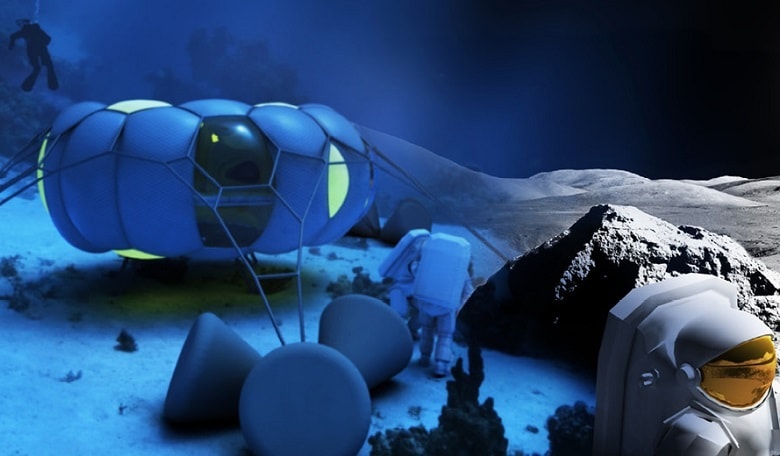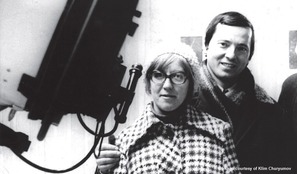The concept of the unity of sciences [1,2] marked a revolution in the search for the truth. Today, at the convergence of fields such as biology and technology (biotechnology), or mechanical engineering and electronics (mechatronics), this perspective has become the state of the art.
Further to the scientific and humanities’ fields of research, artistic research is becoming a research area in its own right applying similar methods; this starts with the same operational system of writing proposals, formulating research questions and describing methods of approaching the problem at hand. Artistic research is a discovery-led form of knowledge production [3] similar to exploring the ‘what’, ‘why’ and ‘when’ of our universe, where the actual questions and methods are only gradually revealed. This kind of artistic research transitions into other disciplines and previously unexplored territory, leading to the discovery of new paths and outlooks. Both art and science are driven by a desire for fundamental understanding (or truth) and a desire for new products. [4]
In the artistic research project ‘Growing As Building’ [5] the above approach is reflected in two ways: methods of science were infused into an arts-based research, and the bio-mimetic nature of the project required an interdisciplinary team comprising biologists, architects, artists and experts from the field of mechatronics, robotics and the physical sciences. They were the prerequisite for approaching the ‘unity of the sciences’ and expanding the project into all of the disciplines mentioned.
The multi-disciplinary team came together to investigate growth principles in nature and ways of applying them to architecture in order to take the first steps towards a self-growing house. The project was developed to look at nature’s technology and try to find meaningful translations into a human made realm: architecture.
If humans want to venture to extraterrestrial surfaces for extended periods of time, we will need a well functioning closed-loop life support system
The scientific methods used in addition to artistic ones were Quality Function Deployment [6] and a hands-on experimental set-up, a biolab. The process of Quality Function Deployment (QFD) is used to link the original idea to the outcome through a set of matrices; it is often applied in industrial product development and originated in Japan. Qualitative relationships are quantified and, in the case of Growing As Building, architectural visions of the self-growing house, growth principles and biological role models were related to each other. A set of first experiments was derived from the QFD-selected biological role models, which were further developed with biological expertise in the biolab.
Blending arts and sciences
The project Growing As Building (GrAB) [7] researched four main themes. Firstly, growth principles in general, especially explorative growth, conducting experiments with slime mould, a single-cell organism which has optimised ‘path finding’. Slime mould became a co-designer to the team in designing connections for an exemplary structure of seven platforms which needed to be connected. Secondly, material systems which focussed on mycelium as fragmented matter, and on how it would develop into a grown building material by adding recycling material based on cellulose. Thirdly, the project was about metabolic systems. The fourth core topic involved two novel mobile 3D printers as the biological transfer into technology.
The latter two topics were interconnected. Metabolic systems included bio-reactors and a biological material as 3D printer material based on calcium carbonate, acid and ethanol. The CO2 produced during the mixing of this bio-printer material is subsequently taken up by the metabolic system of the algae bioreactor, which transforms CO2 into O2 and generates biomass.
The European MELISSA life support system and the concept for the space simulation habitat Medusa inspired were based on concepts similar to the GrAB metabolic system loop, where the algae producing oxygen and energy is integrated. MELISSA (is conceptualised as a closed-loop system and is conceived as a network of five connected biological compartments, each of them with a different biochemical function which allows the exchange of gases and fluids.
Living architecture life support
In continuing this thread of a looped system reflecting the basis of the biosphere we live in, the project Medusa [8] went a step further in integrating living systems into architecture. Medusa too was conceived by an interdisciplinary team comprising architects, engineers, artists and scientists. It presents a holistic approach incorporating life support systems in combination with human factor considerations.
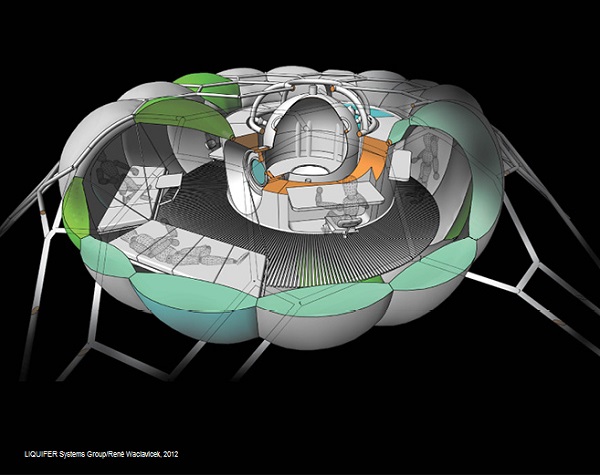 Medusa’s internal design
Medusa’s internal design
Life support is strictly speaking the management of products to sustain the astronaut’s life in the extreme environment of space. However, in the Medusa concept this aspect is seen on a larger scale: a life support system is not only meant to handle the necessary living products (air, food, water and waste) but also contribute to the psychological well-being of the astronauts in their lunar home. The Medusa Life Support System is an integral part of the inflated structure of the habitat. The outer hull of the living spaces will be composed of cells that not only protect the habitants from the extreme environment, but will also create a comfortable atmosphere inside the living volume.
These cells will be filled with water for structural purposes. The majority of the cells will also serve to protect the astronauts from ionizing radiation. These water-filled cells can also be used as windows to the outside, thus increasing the perceived living space and adding a blue light to the internal environment.
A life support system is not only meant to handle the necessary living products but also contribute to the psychological well-being
Other cells will include bioreactors filled with algae that can assist in recycling carbon dioxide to oxygen and deliver food products. These cells are illuminated (by the sun or by artificial light integrated into the cell), and thus add a green, natural environment to the astronauts’ home. They can be exchanged for maintenance or harvesting purposes. The Water Walls Concept developed by space architects Marc Cohen, Renee Matossian and engineer Michael Flynn (NASA Ames) [9] explores the step towards a fully-fledged Medusa-like life support system in more details. The Water Wall takes nature’s approach of being a passive system; chemically passive and massively redundant. This is in contrast to most space agencies’ approaches of using electro-mechanical systems, which tend to be failure sensitive. If humans want to venture to extra-terrestrial surfaces for extended periods of time, we will need a well functioning closed-loop life support system, similar to the system on our spaceship Earth.
Spaceflight parameters
All spaceship and space habitat structures such as Medusa touch on what we call spaceflight parameters: self-sufficiency, limited resources, minimal space, life support systems and using local resources. These parameters are not only for outer space; they can be also applied to terrestrial grounds and to our spaceship Earth, since they represent one step towards being able to sustainably deal with climate change and the limited availability of resources.
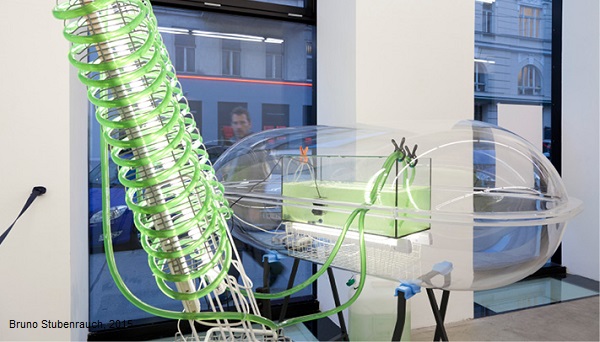
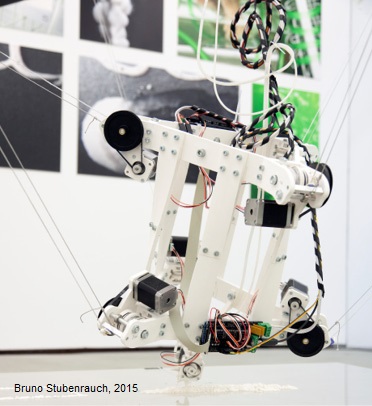 3D mobile printer using calcium carbonate based printer material and algae bio-reactor
3D mobile printer using calcium carbonate based printer material and algae bio-reactor
Test-bed for space and Earth
The Self-deployable Habitat for Extreme Environments (SHEE) [10] takes on these spaceflight parameters and represents both a model for a space simulation habitat for an upcoming lunar surface mission and for a research station in Antarctica, since it can withstand temperatures between -50C and +50C. As a simulation test-bed for preparing human missions to Mars and to the Moon, SHEE is self-sufficient for a two-person crew living autonomously in the hab for two weeks, as they would in a nominal short mission space scenario.
SHEE is thus the first European space habitat simulator, and the first to be deployable through six petals. It is transportable by land, sea and air, and two SHEE units can be fitted into a heavy lift launcher in stowed configuration. Since the habitat is deployable, the interior needs to be transformable and reconfigurable so that the minimal space of approximately 28m2 can be used in various ways. Each crew member has their own private space. They have workspaces, a galley, hygiene facilities and a wet bench for repairs and other maintenance tasks.
The SHEE project addresses the spaceflight parameters of minimal space, self-sufficiency and dealing with limited resources. The LavaHive concept [11] takes these parameters another step further in using local resources and recycled elements at hand on the Martian surface for erecting a habitation structure.
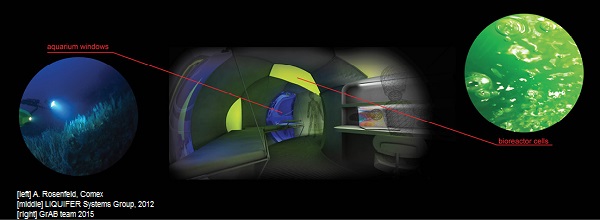 Aquarium windows and bio reactor cells inside MEDUSA
Aquarium windows and bio reactor cells inside MEDUSA
Building with sun and sand
LavaHive is a modular 3D-printed Mars habitat using a novel construction technique called ‘lava-casting’. The habitat is made from regolith, a readily available surface material found on Mars, and uses the abundant energy resource of the sun to construct the habitat.
This process, known as in-situ resource utilisation, can allow for the next stage of human exploration, virtually eliminating the constraints imposed on construction by the current approach, where all necessary materials for habitats need to be launched from Earth.
LavaHive represents a linear configuration allowing for future expansion to include additional elements. The structure is comprised of a main habitation unit, airlock module, maintenance workshop, docking port, laboratory and greenhouse.
The main habitation unit consists of an inflatable structure covered by the back shell of the entry capsule and a sintered apron of Martian soil at its base. By repurposing elements already landed on the surface, another spaceflight parameter is incorporated: recycling, thus perceiving ‘waste’ as a resource.
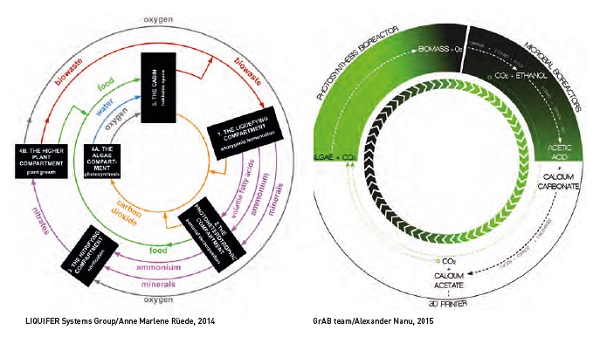 MELISSA support systems. GrAB metabolic system diagram.
MELISSA support systems. GrAB metabolic system diagram.
Unity of sciences and overview effect
Like SHEE, LavaHive was designed by a multidisciplinary team with backgrounds in the fields of engineering, materials science, astrophysics and space architecture. [12] Its interdisciplinary nature supports Descartes’ initial claim for a ‘unity of the sciences’. Combining discovery-led knowledge production with scientific methods fulfils the desire for fundamental understanding, which is intrinsic to the sciences. Further, artistic views tend to produce a reflection of the research topic with a kind of overview effect that helps specialised scientists to connect to other fields. This overview effect can also be observed with astronauts viewing Earth in its entirety and unity, as a whole system, from the windows of their spaceship.
As astronauts of the spaceship Earth our duty is to take good care of our vehicle
Furthermore, no line is to be drawn between terrestrial environments and space, given that we are already in space circling the Sun on our spaceship Earth. Buckminster Fuller provided us with an operational manual for our ‘spaceship’, which is equally as valid today as it was 40 years ago, and focuses on treating the planet with care. As astronauts of the spaceship Earth, our duty is to take good care of our vehicle, similar to the International Space Station (ISS) crewmembers spending a considerate amount of time on their space station. They have to maintain the ISS on a daily basis so it can sustain their lives.
City as a Spaceship
With the current prognosis of three quarters of the world’s population living in cities by 2050 the project City as a Spaceship (CAAS) [13] takes a holistic approach to today’s challenges in mapping spaceflight parameters on the city.
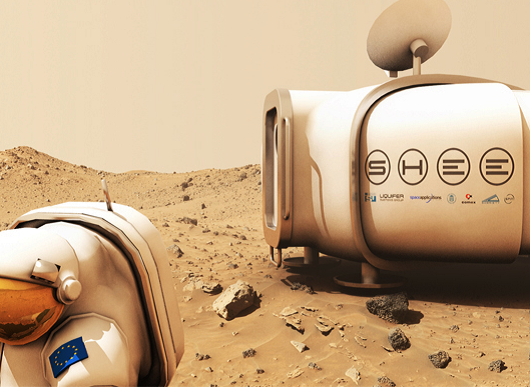 Artist’s impression of SHEE deployed on the surface of Mars
Artist’s impression of SHEE deployed on the surface of Mars
The CAAS project highlights space ecologies such as water regeneration, air revitalisation, living within multi-cultural crews and using energy from renewable resources. One example is IP-Star, a Dutch company which took the water regeneration system from MELISSA and created a terrestrial application for water purification for large hotel structures. Just as water regeneration and air revitalisation in mega-cities is of high importance, based on an approach of responsible resource use, a ‘cradle to cradle’ system, treating waste as a resource and recycling resources wherever possible.
Cities are the biggest consumers of energy, so alternative ways of producing energy must be explored - using wind, the Sun or other renewable energy sources. The ISS, for example, is powered solely by solar energy. Astronauts in the multi-cultural environment of the ISS and its various partners such as US, Russia, Japan and the culturally diverse Europe undergo the same challenges as citizens in a multi-ethnical environment and need to train for this work environment.
Spin-offs from space and thought models adopting spaceflight parameters for a contemporary city model can be used to form an inspiring image of a future city, and can become role models for developing more resilient systems and cities. The idea of CAAS also closes the loop to projects such as GrAB which looks at metabolic systems, nature’s technology and ways to use resources responsibly.
References
1 Descartes, Rene; Discourse de la Method; 1637.
2 Descartes, Rene; Rules for the Direction of the Mind; Rule I; translated by Elizabeth Anscombe and Peter Thomas Geach in 1954; https://en.wikisource.org/wiki/Rules_for_the_Direction_of_the_Mind; as viewed 2.12.2015
3 Borgdorff, Henk; Artistic Research within the fields of science; 2009; http://www.pol.gu.se/digitalAssets/1322/1322679_artistic-research-within-the-fields-of-science.pdf, as viewed 2.12.2015.
4 Borgdorff, Henk; Artistic Research within the fields of science; 2009; http://www.pol.gu.se/digitalAssets/1322/1322679_artistic-research-within-the-fields-of-science.pdf, as viewed 2.12.2015.
5 2.5-year research project, funded by the Austrian Science Fund, 2013-2015, www.growingasbulding.org
6 https://en.wikipedia.org/wiki/Quality_function_dep...
7 Imhof, B.; Gruber, P.; Built to Grow - Blending Architecture and Biology; Birkhauser, 2015
8 Partner of this project are Comex, France, LIQUIFER Systems Group, Austria and Angelo Vermeulen, Delft University of Technology, Participatory Systems, Netherlands.
9 The full team also incorporates Sherwin Gormly and Rosso Mancinelli.
10 SHEE (Self Deployable Habitat for Extreme Environments), a project co-funded under EU-FP 7 and conducted by a consortium comprising International Space University, France; LIQUIFER Systems Group GmbH, Austria; Space Applications Services N.V., Belgium; Institute of Technology, University of Tartu, Estonia; Compagnie Maritime D’Expertises S.A., France; Sobriety s.r.o., Czech Republic; Space Innovations, v.o.s., Czech Republic; more see www.shee.eu
11 Third Prize in competition: NASA 3D Printed Habitat Challenge, awarded at the 2015 World Maker Faire in New York City, 26-27 September 2015; Consortium: European Space Agency’s (ESA) - EAC Spaceship team, LIQUIFER Systems Group; more see www.lavahive.com
12 LaveHive team: ESA Spaceship EAC, LIQUIFER Systems Group, 2015, www-lavahive.com
13 Fairburn, S.; Mohanty, S.; Imhof, B.; CITY AS A SPACESHIP (CAAS), IAC-14-E4.2.8, 65th International Astronautical Congress, Toronto, 2014.





